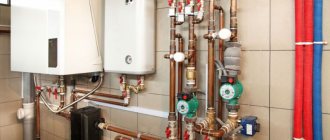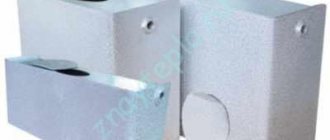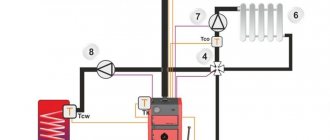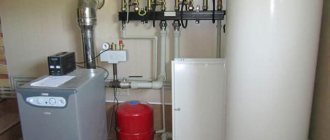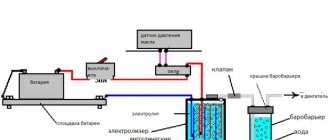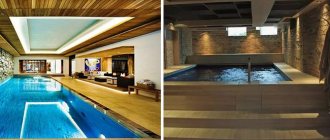In the absence of centralized heating, boilers take on the responsibility for heating the home. To accommodate such equipment, it is necessary to prepare a separate room, observing safety requirements and standards.
Agree, at first glance the task looks difficult. However, it is not. Knowing the basics of calculations, rules and design principles, you will be able to plan the room yourself. A typical boiler room diagram for a private house is developed taking into account the specific type of boiler and a list of additional equipment for the heating system.
We will help you understand the issue, describe the features of different boiler rooms, and outline the requirements and rules for their arrangement. Thematic videos clearly demonstrate examples of organizing premises for installing and piping boilers.
Types of boiler houses for the private sector
The requirements for boiler houses are set out in SNiP with the nomenclature designation II-35-76.
Depending on the location of the room with heating equipment installed in it, boiler rooms can be classified into one of the following types:
- built-in;
- free-standing;
- attached.
The dimensions of the room allocated for the boiler room are selected based on the type of fuel and the type of boiler design.
When it is difficult to arrange a special room for a boiler room, there is another option - a mini-boiler room.
It is placed in a container assembled according to the principle of metal structures, which can be placed in the courtyard of the house. All that remains is to connect the mini-boiler room to the communications.
Image gallery
Photo from
Selecting a boiler room by type of placement
Freestanding boiler room
Location of private boiler room
Combustion product removal system
The not very popular popularity of such modules is explained by their rather high cost. If there is a prospect of allocating space for a boiler room in the basement, you can buy the equipment separately. Then the heating system will cost much less.
A mini-boiler room in the courtyard next to the mansion eliminates the need for design work, construction and arrangement of a separate room, and ventilation equipment. The container already contains everything you need for the efficient functioning of the heating system
What is a “smart boiler”
To implement an automation scheme for a private boiler room, you need to invest additional funds. A simple thermostatic valve will cost very little, but programmable systems are many times more expensive.
Constant operation of a conventional boiler in one mode entails a large consumption of electricity and money. Therefore, the cost of purchasing an automation unit quickly pays off during operation.
Automation in a private boiler room guarantees the functioning of the heating system with maximum efficiency, which allows for comfortable conditions for residents living in the house.
By installing automation, the home owner can adjust the heating process according to his needs. Thanks to this, bills for consumed energy resources will be reduced by 2 times.
Controlling the boiler in automatic mode makes it possible to:
- Turn off the boiler in case of an unusual situation. Carry out automatic start or stop of the boiler in the current mode. Depending on the outside temperature, set the heating temperature.
- Manage the heating or water heating branches of a boiler with 1 combustion chamber.
- Regulate the temperature of water or other coolant.
- Make adjustments to the operation of the circulation or recirculation pumps if the heating system in the house is arranged in a closed circuit. In this case, the system cannot function without automation.
The most important element of the heating system is the thermostat. Its function is to regulate the temperature both in a separate room and in the entire house.
There are many types of thermostats - from simple mechanical to weather-compensated. The latter is the most technologically advanced, profitable, but also very expensive.
The heating control system consists of a temperature controller (1), an outside air temperature sensor (2), an actuator (3), a coolant temperature sensor (4), a display for connecting to an external control system (5), a circulation pump (6) , coolant supply (7), consumer circuits (8) (+)
The price of automation depends on the type of boiler used, the presence of heated floors, solar collectors, etc. In order not to spend extra money, you should analyze the features of all schemes and calculate the cost. It is quite difficult to do this yourself, but you can always turn to specialists with this problem.
Boiler house installation
Since the boiler room design may include their installation both in a residential building and separately, the requirements for the equipment also differ. So, if the complex is located in one of the rooms of the house, in some cases (for example, if there is a noisy forced-air burner), additional sound insulation may be needed.
While boilers installed in individual buildings are the safest and most practical option, although they require relatively large capital investments.
The basic equipment needed to operate a heating system usually does not depend on the location of the room, or even on the type of fuel used to operate it. Almost all boiler rooms consist of the following elements:
- heating boiler;
- boiler (water heater);
- expansion tank;
- distribution manifolds;
- chimneys;
- safety and boiler feed systems;
- pipes and shut-off valves.
Heating boilers
The boilers in this complex are heat generators. Fuel combustion occurs in them, due to which the coolant (usually water, less often antifreeze) is heated and supplied to the water heating system and to the boiler (if available), which is necessary to provide housing with hot water.
A heated liquid circulates inside such a device, increasing the temperature of the water used for domestic needs.
Tanks and collectors
The purpose of expansion tanks is to compensate for excess coolant pressure to eliminate the risk of creating an emergency situation in the heating system of a private home, in which pipes may burst.
A distribution manifold, consisting of a pump, hydraulic separator and comb, is necessary for proper circulation of the coolant and its uniform flow into the various circuits of the system (hot water supply, radiators, “warm floors”).
Chimneys and security systems
Chimneys are necessary to remove combustion products from the boiler room. Not only the safety, but also the efficiency of the boilers depends on how they are installed and the parameters are selected.
And the tasks of the make-up and safety systems are to control the pressure of the liquid circulating through the pipelines. Only the first prevents a decrease in pressure due to leaks and evaporation, and the second, on the contrary, increases it by removing air from the pipes.
Automation and fittings
Automation installed in mini boiler rooms of a private house is necessary for the operation of equipment (turning on, turning off, setting the required air parameters) in the absence of a person and ensuring additional safety of heating and hot water supply systems.
It may depend on the power supply (in this case, the boiler can work independently for up to several days) or have mechanical regulators. Pipes and shut-off valves are required to ensure water circulation in the system.
Gas boiler room for your home
Gas is an explosive substance, so the requirements for gas boiler houses are very strict. If a boiler with a power of up to 30 kW is sufficient to heat the house, then there is no need for a separate room for the boiler room.
The boiler can be placed in a well-ventilated kitchen on a wall made of non-combustible materials, provided that the volume of the room is at least 15 m ᶾ, the height from floor to ceiling is from 2.5 m, and the floor area is from 6 m².
If there are no walls made of non-combustible materials in the kitchen, then the boiler is installed on a surface plastered and insulated with a special screen
All requirements for gas boiler houses are related to preventing the consequences of possible gas leaks. For this purpose, the window area in the room where gas equipment is installed starts from 0.5 m², and the door width from 0.8 m.
The chimney of such a boiler room must rise above the roof ridge by at least 500 cm and have an additional channel for cleaning. Condensate collectors must be installed on the chimney and ventilation.
When gas enters the boiler, electronic or piezo ignition is turned on. A spark occurs and it ignites the igniter, and from it the main burner, heating the coolant to the set temperature. Next, the automation turns off the burner
If the power of a gas boiler exceeds 30 kW, then a separate building is required for it.
The requirements for a separate boiler room are set out in the building codes:
- the foundation of the boiler room building must be separate from the foundation of the house;
- a certain percentage of sand must be present in the concrete solution used in the construction of the building;
- a separate foundation is placed under the boiler, raising it above the finished floor by 0.2 m;
- under the boiler you need a backing made of flat slate or tiles protruding beyond its limits by 0.1 m along the entire perimeter;
- to drain the coolant in case of an emergency, the boiler room must be equipped with a sewerage system;
- within a radius of 0.7 m around the boiler, the space must be free;
- interior decoration must have a fire resistance rating of 0.75 hours.
There are special regulatory requirements for the boiler itself, since it does not belong to the category of household appliances, but to the category of complex engineering equipment. Gas boilers, like all others used in the domestic sector, must have a certificate certifying that they have passed a safety examination.
Control services will never give permission to put into operation a boiler room with a gas boiler if there is no gas detector in the room.
Features of the construction of different types of boiler equipment
In industrial enterprises, plants and factories, stationary powerful boiler rooms are usually built in a separate room, which allow a large industrial facility to operate efficiently, but for private homes, offices, baths and saunas, mini-boiler rooms and mobile equipment are used that generate a sufficient amount of heat for a small facility . In addition, the construction of large boiler houses for industrial enterprises is carried out directly on site, since transportation of such bulky structures is not always possible.
Block-modular boiler houses are the most optimal type of boiler houses, which are suitable for both small factories and large manufacturing enterprises. These are separate buildings with ready-made installation inside, which are delivered to the site already assembled. Only the system is connected and monitored on site.
Gas boiler houses are also a common type today. Firstly, they are environmentally friendly, safe, economical and versatile - they are used both for housing, offices, shops, shopping centers, and industrial facilities. They operate on natural, liquefied or associated petroleum gas.
For boiler houses that operate on solid or liquid fuels, it is important to equip a special room where the fuel will be stored. Liquid fuel also requires a special heating system. According to the standards, the room where fuel is stored must be outside the attached boiler room. Liquid fuel can also be stored in underground premises (basements, warehouses) subject to all storage standards.
When constructing a boiler house, it is also necessary to construct combustion product purification systems. The choice of such systems depends on the type of fuel on which the boiler room operates.
Boiler room with solid fuel boiler
In accordance with the requirements of building codes, solid fuel boilers are installed only in non-residential premises. If the power of the unit is large, the construction of a separate boiler room will be required.
What should the room be like?
There are a number of requirements for placement under a solid fuel boiler:
- the distance between the firebox door and the wall is from 1.2 to 1.5 m;
- the distance from the side walls of the boiler to a wall made of fireproof material or protected by a special screen is at least 1 m;
- the gap between the rear wall of the boiler and the surface of combustible material with a protective screen is at least 0.5 m for boilers with a rear connection;
- ban on superstructures above the boiler room;
- effective supply ventilation , located in the lower part in the form of a gap between the door and the floor or a hole in the wall.
If the wall is made of material that meets fire safety requirements, then it is permissible to attach the pipe located behind the boiler to it using brackets.
In order to operate a CT with parameters of 1x0.8 m at the base with at least a minimum of comfort, you need to install it in a room of 2.8x2.5 m. As the dimensions of the unit increase, the area of the boiler room also increases.
It is necessary to plan the installation of a solid fuel boiler at the stage of building a house in order to allocate space for the chimney in advance
If the boiler room is in the form of an extension, then the correct location for it is a blank wall. The distance to windows and doors in both vertical and horizontal directions must be at least 1 m. If the boiler room is located in the basement, ground floor or first floor, it is necessary to install a door that opens outward.
Equipment for solid fuel boiler house
A functional and well-designed diagram of a boiler room with a solid fuel boiler should include a number of elements:
- Heat generator equipped with appropriate bunkers, fuel chambers, etc.
- TT boiler piping , consisting of a circulation pump, 3-way valve, safety group.
- Chimney.
- water heater for supplying the house with hot water.
- Automation - weather-dependent or in-house.
- Fire extinguishing system.
Coal, peat, and firewood are used as fuel for TT. The diameter of the chimney in a boiler room with a TT unit must be equal to the cross-section of the boiler pipe. The room requires exhaust ventilation, designed so that for every 8 cm² of its area there is 1 kW of boiler power. If the boiler is installed in the basement, this parameter is multiplied by 3.
A steel sheet must be laid around the base of the boiler. It needs to protrude 1 m on each side. The layer of plaster on the walls should be no less than 3 cm thick.
In the chimney itself, which has the same cross-section along its entire length, holes are provided for collecting and removing soot. A mandatory attribute is fire extinguishing equipment.
A high-quality solid fuel boiler is capable of converting any type of solid fuel into thermal energy. This allows you to save money
For 1 kW of TT boiler power there should be about 0.08 m² of glazing area. The maximum permissible area of the boiler room is 8 m². If you plan to load the firebox with coal, then the electrical wiring must be protected from coal dust, because it can explode at a certain concentration.
Scope of use of gas boiler equipment
It forms an important part of the engineering design of residential, industrial, agricultural, public, and construction projects. Catering establishments, sauna and bath complexes, laundries, dry cleaners - the group of users includes companies of almost any profile. In the agricultural sector, a gas boiler room is used for drying grain, heating greenhouses, and heating livestock farms.
boiler equipment has found wide application in a wide variety of processes:
- technical and technological;
- hot water supply;
- heating;
- ventilation.
Among all types of equipment for a gas boiler house (solid, liquid fuel and gas), gas systems are most widespread. Against the backdrop of the dynamic development of the coldest regions of northern and eastern Russia, the demand for them is constantly growing. And the efficiency of gas in terms of thermal energy production is fully justified by the efficiency of modern heating equipment for the boiler room and the low costs of their operation.
Advantages of a liquid fuel boiler
Installing an oil-fuel boiler is much easier than a gas or solid-fuel counterpart. You can place it in the house and in the yard.
The main advantage is the absence of the need for approval and obtaining permits. All that is required from the owner of the house is to provide free access for a car with fuel and regularly refuel the boiler.
If there is no gas main near the country house, you can install a unit that runs on diesel fuel in the boiler room. A double-circuit boiler will heat the house and provide residents with warm water
To obtain 10 kW of power, about 1 liter of diesel fuel is consumed, but the exact consumption depends on the quality of the fuel. In the middle zone, with a house area of 200 m², about 5 thousand liters of fuel will be required for the heating season. The chimney must be cleaned periodically.
To install a diesel boiler, an average of 4 m² is required. If supply ventilation is provided by air flow from other rooms of the house, then per 1 kW of boiler power there should be at least 30 cmᶾ of air. With external ventilation this figure decreases to 8 cmᶾ.
Electric boiler for a private boiler room
Of all the models used in a private home, the safest is the electric boiler. It is not necessary to equip a separate boiler room for it. When heating the coolant, no combustion products are released, so ventilation is not needed for it.
Installation of such boilers is simple, they do not create noise during operation, and they are easy to care for. Electric boilers have high efficiency, reaching 99% in some cases. The disadvantage is the high requirements for network power, as well as the dependence on its stable operation.
You can place an electric boiler in any corner of the house, as long as it is convenient. It consumes a lot of electricity and is most often used as an additional heat source
The connection of an electric boiler is carried out according to different schemes: it is connected to heating radiators, and the possibility of installing a cascade is provided in cases where it is necessary to heat a large area.
The piping is carried out according to two schemes - direct and mixing. In the first case, the temperature is controlled using a burner, and in the second, using a servo-driven mixer.
Tips and tricks
Experience in operating Russian and foreign heating equipment makes it possible to formulate a number of tips and recommendations, taking into account which will help to avoid additional costs and ensure a comfortable standard of living:
- Installing a voltage stabilizer will protect the electronic boards or automation of the heating boiler from failure due to power surges. Such boards cannot be repaired, and the cost of replacement can reach 30% of the price of the entire boiler
- A sewer drain with a drain in the boiler room floor will help avoid flooding of the room in the event of a coolant leak or an accident in the water supply circuit
- Installation of a boiler room in a private house with the installation of a heating control system based on outside or room temperature brings significant savings in the form of reduced fuel costs. The size of such savings over a period of two to three years exceeds the cost of additional costs for installing such automation
- When using antifreeze, you must remember that not all boiler manufacturers allow it to be used in their products. Using it in boilers from such manufacturers may lead to loss of warranty.
- Aluminum and copper form a galvanic couple, which leads to accelerated corrosion of the compounds of these metals. For this reason, contact of aluminum radiators in the boiler room with the copper pipe of the heating circuit should be avoided
- In the absence of automatic temperature control in individual rooms, it is advisable to install adjustable valves with thermostatic heads on radiators. This solution automatically maintains the set temperature
- An important role in the layout of equipment is played by the requirement of its maintainability. Easy and convenient access to all elements when urgent repairs or replacement of equipment in a boiler room in a private house is necessary - a guarantee of quick and easy troubleshooting and accidents
Read other articles on this topic
| Wood-burning boiler for heating a house - do-it-yourself installation | Standards for designing a boiler room in a private house |
| Detached boiler room for a private house | Modular gas boiler room |
| How to choose a boiler for heating your home | Combined heating boilers: types, features |
| Installation of a heating main from a separate boiler room to a private house | Diesel heating boilers |
| Gas boiler room in a private house | Electric boilers for heating a private home: features, how to choose, application |
| How to choose a gas boiler for heating a private house |
Services on this topic
| Installation of a boiler room in a private house | Boiler house design |
| Turnkey installation of boiler rooms | Installation of a gas heating boiler |
| Installation of gas boiler rooms | Installation of home heating boilers |
| Installation of an electric heating boiler | Installation of a solid fuel boiler |
| Installation of a pellet boiler | Installation of a diesel boiler |
| Installation of wall-mounted gas boilers | Installation of a gas boiler in a private house |
| Cost of installation of gas boilers | Installation of floor-standing gas boilers |
